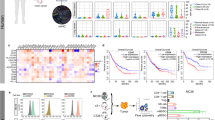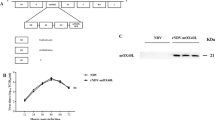Abstract
Carrier cells delivering a conditionally replicating adenovirus (CRAd), which selectively replicates in tumor cells and induces tumor cell lysis, have promising potential for treatment of cancer because CRAd-loaded carrier cells evade inhibition by neutralizing anti-adenovirus (Ad) antibodies and because the carrier cells are locally retained at the injection point after local injection. A previous study by Hamada et al. demonstrated that carrier cells (CRAd-containing cell fragments derived from the carrier cells) are engulfed into the target cells, probably through a pathway independent of the primary receptor for Ad, the coxsackievirus and Ad receptor (CAR) (Mol Ther, 15: 1121–1128; 2007); however, it remains to be elucidated whether carrier cells infected with a conventional CRAd, which is composed of subgroup-C Ad serotype-5 (Ad5), mediate antitumor effects on CAR-negative cells. In order to examine whether carrier cells delivering a conventional CRAd (Carrier-F5) induce lysis of CAR-negative tumor cells, CAR-positive and CAR-negative tumor cells were incubated with Carrier-F5. Carrier-F5 mediated efficient killing of CAR-positive tumor cells; however, CAR-negative tumor cells were almost refractory to Carrier-F5. On the other hand, carrier cells loaded with a fiber-substituted CRAd containing fiber proteins of Ad serotype-35 (Ad35) (CRAd-F35), which binds to human CD46 for infection, showed efficient killing of both CAR-positive and CAR-negative tumor cells. Intra-tumoral injection of carrier cells loaded with CRAd-F35 (Carrier-F35) also resulted in efficient regression of both CAR-positive and CAR-negative tumors. These results demonstrated that the expression levels of receptors for Ad are an important factor for CRAd-loaded carrier cell-mediated cancer therapy, and that Carrier-F35 would have potential as a cancer treatment for not only CAR-positive tumors but also CAR-negative tumors.
This is a preview of subscription content, access via your institution
Access options
Subscribe to this journal
Receive 12 print issues and online access
$259.00 per year
only $21.58 per issue
Buy this article
- Purchase on Springer Link
- Instant access to full article PDF
Prices may be subject to local taxes which are calculated during checkout





Similar content being viewed by others
References
Pesonen S, Kangasniemi L, Hemminki A . Oncolytic adenoviruses for the treatment of human cancer: focus on translational and clinical data. Mol Pharm 2010; 8: 12–28.
Yamamoto M, Curiel DT . Current issues and future directions of oncolytic adenoviruses. Mol Ther 2010; 18: 243–250.
Nemunaitis J, Tong AW, Nemunaitis M, Senzer N, Phadke AP, Bedell C et al. A phase I study of telomerase-specific replication competent oncolytic adenovirus (telomelysin) for various solid tumors. Mol Ther 2010; 18: 429–434.
Li JL, Liu HL, Zhang XR, Xu JP, Hu WK, Liang M et al. A phase I trial of intratumoral administration of recombinant oncolytic adenovirus overexpressing HSP70 in advanced solid tumor patients. Gene Ther 2009; 16: 376–382.
Freytag SO, Movsas B, Aref I, Stricker H, Peabody J, Pegg J et al. Phase I trial of replication-competent adenovirus-mediated suicide gene therapy combined with IMRT for prostate cancer. Mol Ther 2007; 15: 1016–1023.
Ophorst OJ, Radosevic K, Havenga MJ, Pau MG, Holterman L, Berkhout B et al. Immunogenicity and protection of a recombinant human adenovirus serotype 35-based malaria vaccine against Plasmodium yoelii in mice. Infect Immun 2006; 74: 313–320.
Chirmule N, Propert K, Magosin S, Qian Y, Qian R, Wilson J . Immune responses to adenovirus and adeno-associated virus in humans. Gene Ther 1999; 6: 1574–1583.
Suzuki T, Sakurai F, Nakamura S, Kouyama E, Kawabata K, Kondoh M et al. miR-122a-regulated expression of a suicide gene prevents hepatotoxicity without altering antitumor effects in suicide gene therapy. Mol Ther 2008; 16: 1719–1726.
Mizuguchi H, Hayakawa T . Enhanced antitumor effect and reduced vector dissemination with fiber-modified adenovirus vectors expressing herpes simplex virus thymidine kinase. Cancer Gene Ther 2002; 9: 236–242.
Toloza EM, Hunt K, Swisher S, McBride W, Lau R, Pang S et al. In vivo cancer gene therapy with a recombinant interleukin-2 adenovirus vector. Cancer Gene Ther 1996; 3: 11–17.
Hamada K, Desaki J, Nakagawa K, Zhang T, Shirakawa T, Gotoh A et al. Carrier cell-mediated delivery of a replication-competent adenovirus for cancer gene therapy. Mol Ther 2007; 15: 1121–1128.
Komarova S, Kawakami Y, Stoff-Khalili MA, Curiel DT, Pereboeva L . Mesenchymal progenitor cells as cellular vehicles for delivery of oncolytic adenoviruses. Mol Cancer Ther 2006; 5: 755–766.
Stoff-Khalili MA, Rivera AA, Mathis JM, Banerjee NS, Moon AS, Hess A et al. Mesenchymal stem cells as a vehicle for targeted delivery of CRAds to lung metastases of breast carcinoma. Breast Cancer Res Treat 2007; 105: 157–167.
Hakkarainen T, Sarkioja M, Lehenkari P, Miettinen S, Ylikomi T, Suuronen R et al. Human mesenchymal stem cells lack tumor tropism but enhance the antitumor activity of oncolytic adenoviruses in orthotopic lung and breast tumors. Hum Gene Ther 2007; 18: 627–641.
Alcayaga-Miranda F, Cascallo M, Rojas JJ, Pastor J, Alemany R . Osteosarcoma cells as carriers to allow antitumor activity of canine oncolytic adenovirus in the presence of neutralizing antibodies. Cancer Gene Ther 2010; 17: 792–802.
Okegawa T, Pong RC, Li Y, Bergelson JM, Sagalowsky AI, Hsieh JT . The mechanism of the growth-inhibitory effect of coxsackie and adenovirus receptor (CAR) on human bladder cancer: a functional analysis of car protein structure. Cancer Res 2001; 61: 6592–6600.
Segerman A, Atkinson JP, Marttila M, Dennerquist V, Wadell G, Arnberg N . Adenovirus type 11 uses CD46 as a cellular receptor. J Virol 2003; 77: 9183–9191.
Gaggar A, Shayakhmetov DM, Lieber A . CD46 is a cellular receptor for group B adenoviruses. Nat Med 2003; 9: 1408–1412.
Mizuguchi H, Kay MA . Efficient construction of a recombinant adenovirus vector by an improved in vitro ligation method. Hum Gene Ther 1998; 9: 2577–2583.
Mizuguchi H, Kay MA . A simple method for constructing E1- and E1/E4-deleted recombinant adenoviral vectors. Hum Gene Ther 1999; 10: 2013–2017.
Sakurai F, Kawabata K, Yamaguchi T, Hayakawa T, Mizuguchi H . Optimization of adenovirus serotype 35 vectors for efficient transduction in human hematopoietic progenitors: comparison of promoter activities. Gene Ther 2005; 12: 1424–1433.
Kohno S, Nakagawa K, Hamada K, Harada H, Yamasaki K, Hashimoto K et al. Midkine promoter-based conditionally replicative adenovirus for malignant glioma therapy. Oncol Rep 2004; 12: 73–78.
Terao S, Shirakawa T, Kubo S, Bishunu A, Lee SJ, Goda K et al. Midkine promoter-based conditionally replicative adenovirus for targeting midkine-expressing human bladder cancer model. Urology 2007; 70: 1009–1013.
Mizuguchi H, Hayakawa T . Adenovirus vectors containing chimeric type 5 and type 35 fiber proteins exhibit altered and expanded tropism and increase the size limit of foreign genes. Gene 2002; 285: 69–77.
Maizel Jr JV, White DO, Scharff MD . The polypeptides of adenovirus. I. Evidence for multiple protein components in the virion and a comparison of types 2, 7A, and 12. Virology 1968; 36: 115–125.
Mizuguchi H, Koizumi N, Hosono T, Utoguchi N, Watanabe Y, Kay MA et al. A simplified system for constructing recombinant adenoviral vectors containing heterologous peptides in the HI loop of their fiber knob. Gene Ther 2001; 8: 730–735.
Sakurai F, Nakamura S, Akitomo K, Shibata H, Terao K, Kawabata K et al. Transduction properties of adenovirus serotype 35 vectors after intravenous administration into nonhuman primates. Mol Ther 2008; 16: 726–733.
Koizumi N, Kawabata K, Sakurai F, Watanabe Y, Hayakawa T, Mizuguchi H . Modified adenoviral vectors ablated for coxsackievirus–adenovirus receptor, alphav integrin, and heparan sulfate binding reduce in vivo tissue transduction and toxicity. Hum Gene Ther 2006; 17: 264–279.
Sakurai F, Murakami S, Kawabata K, Okada N, Yamamoto A, Seya T et al. The short consensus repeats 1 and 2, not the cytoplasmic domain, of human CD46 are crucial for infection of subgroup B adenovirus serotype 35. J Control Release 2006; 113: 271–278.
Pereboeva L, Komarova S, Mikheeva G, Krasnykh V, Curiel DT . Approaches to utilize mesenchymal progenitor cells as cellular vehicles. Stem Cells 2003; 21: 389–404.
Sonabend AM, Ulasov IV, Tyler MA, Rivera AA, Mathis JM, Lesniak MS . Mesenchymal stem cells effectively deliver an oncolytic adenovirus to intracranial glioma. Stem Cells 2008; 26: 831–841.
Tashiro K, Kondo A, Kawabata K, Sakurai H, Sakurai F, Yamanishi K et al. Efficient osteoblast differentiation from mouse bone marrow stromal cells with polylysin-modified adenovirus vectors. Biochem Biophys Res Commun 2009; 379: 127–132.
Mizuguchi H, Sasaki T, Kawabata K, Sakurai F, Hayakawa T . Fiber-modified adenovirus vectors mediate efficient gene transfer into undifferentiated and adipogenic-differentiated human mesenchymal stem cells. Biochem Biophys Res Commun 2005; 332: 1101–1106.
Fishelson Z, Donin N, Zell S, Schultz S, Kirschfink M . Obstacles to cancer immunotherapy: expression of membrane complement regulatory proteins (mCRPs) in tumors. Mol Immunol 2003; 40: 109–123.
Seshidhar Reddy P, Ganesh S, Limbach MP, Brann T, Pinkstaff A, Kaloss M et al. Development of adenovirus serotype 35 as a gene transfer vector. Virology 2003; 311: 384–393.
Sumida SM, Truitt DM, Lemckert AA, Vogels R, Custers JH, Addo MM et al. Neutralizing antibodies to adenovirus serotype 5 vaccine vectors are directed primarily against the adenovirus hexon protein. J Immunol 2005; 174: 7179–7185.
Power AT, Bell JC . Cell-based delivery of oncolytic viruses: a new strategic alliance for a biological strike against cancer. Mol Ther 2007; 15: 660–665.
Guo ZS, Thorne SH, Bartlett DL . Oncolytic virotherapy: molecular targets in tumor-selective replication and carrier cell-mediated delivery of oncolytic viruses. Biochim Biophys Acta 2008; 1785: 217–231.
Yong RL, Shinojima N, Fueyo J, Gumin J, Vecil GG, Marini FC et al. Human bone marrow-derived mesenchymal stem cells for intravascular delivery of oncolytic adenovirus Delta24-RGD to human gliomas. Cancer Res 2009; 69: 8932–8940.
Shayakhmetov DM, Li ZY, Ternovoi V, Gaggar A, Gharwan H, Lieber A . The interaction between the fiber knob domain and the cellular attachment receptor determines the intracellular trafficking route of adenoviruses. J Virol 2003; 77: 3712–3723.
Kawakami Y, Li H, Lam JT, Krasnykh V, Curiel DT, Blackwell JL . Substitution of the adenovirus serotype 5 knob with a serotype 3 knob enhances multiple steps in virus replication. Cancer Res 2003; 63: 1262–1269.
Acknowledgements
We thank Koyori Yano, Emi Suzuki-Kouyama (National Institute of Biomedical Innovation, Osaka, Japan) and Sayuri Okamoto (Graduate School of Pharmaceutical Sciences, Osaka University, Osaka, Japan) for help. This work was supported by grants from the Ministry of Health, Labour, and Welfare of Japan, and a Grant-in-Aid for Scientific Research (B) of the Ministry of Education, Culture, Sports, Science, and Technology (MEXT) of Japan.
Author information
Authors and Affiliations
Corresponding author
Ethics declarations
Competing interests
The authors declare no conflict of interest.
Rights and permissions
About this article
Cite this article
Iguchi, K., Sakurai, F., Tomita, K. et al. Efficient antitumor effects of carrier cells loaded with a fiber-substituted conditionally replicating adenovirus on CAR-negative tumor cells. Cancer Gene Ther 19, 118–125 (2012). https://doi.org/10.1038/cgt.2011.74
Received:
Revised:
Accepted:
Published:
Issue Date:
DOI: https://doi.org/10.1038/cgt.2011.74
Keywords
This article is cited by
-
Ontology-based representation and analysis of host-Brucella interactions
Journal of Biomedical Semantics (2015)



